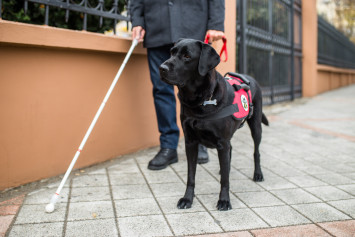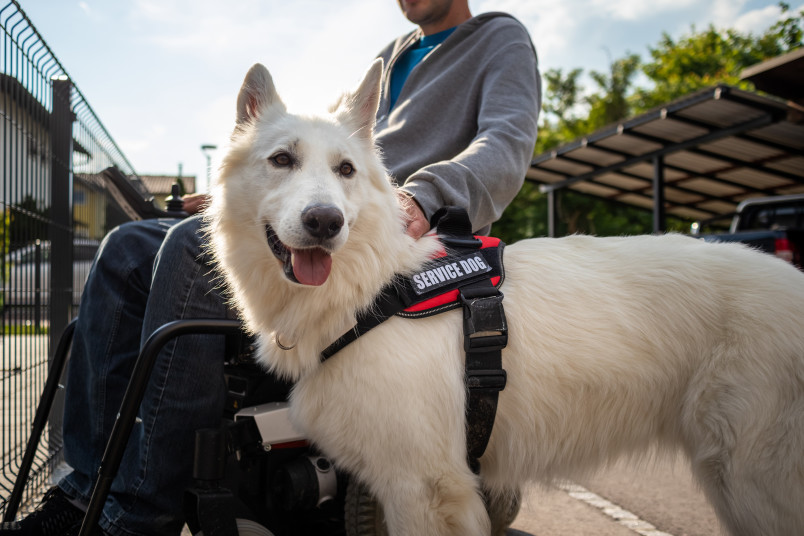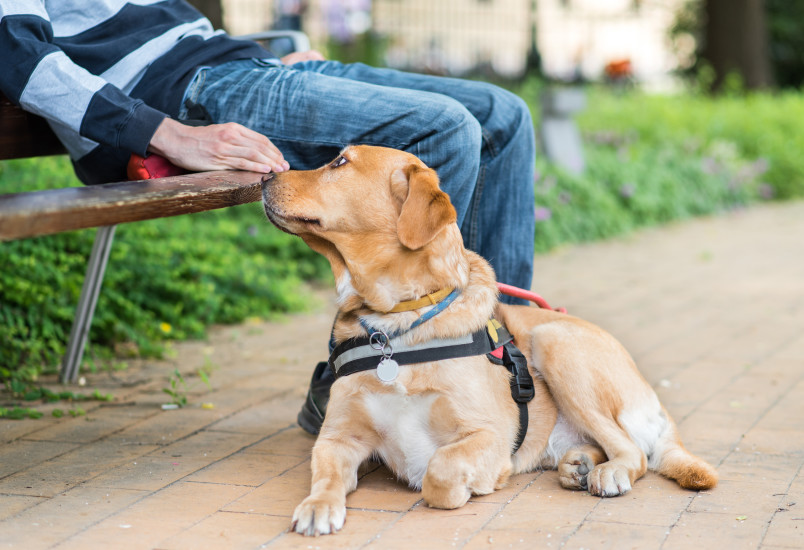
Imagine the life-changing freedom of having a furry companion by your side, trained to assist with everyday tasks or navigate challenging situations. This isn't just about adorable tricks; it's about empowerment and independence for individuals with disabilities. Service dogs are indispensable accessibility and healthcare tools for at least half a million Americans but what does the label “service dog” really mean, and what can or should a service dog do?
Service Dogs
The Americans with Disabilities Act is the leading resource for animals as disability aids. They define service animals as “dogs that are individually trained to do work or perform tasks for people with disabilities”. This includes dogs of any breed or size but does not include other species except in specific situations where a miniature horse may be used. Cats cannot be service animals.
The work or tasks each dog performs depends entirely on their owners’ medical conditions or personal needs. Just as a human with Type 1 Diabetes may rely on an insulin pump to administer insulin and alert to abnormalities, a service dog is essential to the full healthcare management picture for many people with disabilities.
Eligibility for a Service Dog
Most people imagine a guide dog assisting a vision impaired person when they hear the phrase “service dog”, however a variety of disabilities can qualify for use of a service dog. An abbreviated, but not exhaustive list of possible conditions may include:
Blind or vision impaired
Deaf or hearing impaired
Seizure disorders
Cardiac disorders
Diabetes
PTSD and other anxiety or psychological conditions
Humans who require mobility aids
Service animals are working animals, and to hold the title they must be trained to perform work or tasks directly related to their handler’s disability. The training doesn’t have to be professional, in fact it’s possible for a person with a disability to train their own service animal, however there are professional services (such as Guiding Eyes for the Blind) who can train the dog for their handler.
Service dogs must be well behaved and must be trained to be responsive to their handler. The handler must always be able to maintain control, and the animal must be housetrained and able to function while harnessed, leashed, or tethered unless the handler’s disability means use of those devices isn’t possible.

Training Your Dog to Be a Service Dog
You can train your own dog to be a service animal, a professional training program isn’t required. However, the training must include not only the specific tasks or work related to the handler’s disability, but also basic obedience, proper socialization and behavior in public spaces, and housetraining. Why are these parameters just as important as training for the task? While the service dog is intended to assist their handler (and they must be, to be a service dog), they must also be safe to have in public. This means reactive, disobedient, or poorly trained dogs are not eligible for service dog status. Nor are dogs who may pose a human health risk or physical hazard by being unable to control their bodily functions in public spaces, where contamination poses significant risk to others.
Choosing the Right Breed and Temperament for a Service Dog
There are no limitations on breed or dog size for service dogs, but every breed’s temperament is different, so choosing carefully is important. The breeding source is important to consider too. Dogs who come from well-bred lines with predictable temperaments and healthy genetics are much better candidates than dogs sourced from backyard breeders or puppy mills. This is why organizations like Guiding Eyes for the Blind rely almost exclusively on Labrador Retrievers and German Shepherd dogs when raising and training future guide dogs.
Service dogs who need to be able to retrieve, open doors, physically assist their handlers, etc. should be appropriately sized and sturdy, and have breed traits and behavioral characteristics that match these needs.
Choosing the right animal is a key factor in breed choice, but lifestyle should also be a consideration. Great Danes may be difficult to manage in a studio apartment, and a Border Collie may develop behavioral issues if not given adequate room to move and exercise. Beagles are considered by some to be one of the hardest dogs to train, because of their obstinate temperament and affinity for sniffing their way into trouble. They’re also known for their vocal expression, so are less than ideal for closely placed homes or apartments with thin walls.
There’s no one ideal breed for service dog work, so consulting with reputable breeders and even veterinarians can help you determine which breeds may best suit your lifestyle and assistance needs.
Registering and Certifying a Service Dog
The A.D.A. doesn’t require that service animals meet any service-dog certification or registration criteria, though professional certification courses are available and state or local governments can offer voluntary service dog registration programs. Otherwise, no governing body is permitted to require registration or certification.
There are advertised service dog certifications or registrations on the internet, however, because neither of these are required, and because legally no one is permitted to ask you for such documentation, these resources are not recommended for someone with a service dog.
However, service dogs are required to be licensed and vaccinated according to local ordinances, so service dogs should always be kept up-to-date on veterinary healthcare and licensing through local municipalities.

Legal Rights and Responsibilities of Service Dog Owners
Under the Americans with Disabilities Act, service animals must be permitted to accompany their disabled handler into all public access areas. This doesn’t necessarily mean the dog has to be welcomed everywhere – in fact a hospital or restaurant, for instance, may prohibit the animal’s access to areas where the public is generally not welcomed, especially if the dog’s presence could pose a human health risk. This would include operating rooms or kitchen areas not open to the public. Otherwise, public access rights must be accommodated. Service dogs can enter private businesses, grocery stores, restaurants, hospitals and doctors' offices, public arenas and sporting facilities, etc.
A handler with a service dog can only be asked to remove the dog if the dog is out of control and the handler cannot adequately regain control, or it’s clear that the dog is not housebroken. In both situations, regardless of the animal’s service to the handler, the handler must comply with orders for the animal to be removed (the disabled handler cannot be ejected for this reason, only the animal). A service animal cannot be ejected, though, simply because another occupant of the space claims an allergy or fear of dogs.
In a public setting, if the legitimacy of the animal’s status as a service dog bears question, an inquisitor may ask if the dog is a service animal that is required because of a disability, and they may also ask what work or task the dog has been trained to perform. At no point is anyone, even a business owner, permitted to demand documentation, require that the dog demonstrate its work or task, or ask about the person’s disability. Asking these questions is a violation of the Americans with Disability act.
Maintaining your Service Dog's Health and Well-being
While the service dog serves important lifestyle and healthcare roles for their handlers, it is your responsibility to also meet the dog’s healthcare needs. Every service dog should have a well-established history of veterinary care, including both routine wellness care, and proper veterinary care if the dog is sick or injured. Pet Insurance is a great way for service dog handlers with disabilities to manage their dog’s healthcare with less stress and greater assurance, especially given the extra range of dangers that service dogs facedue to their work environments and tasks. This could include exposure to pathogens in public spaces, injuries from falls or accidents, or wear and tear on their joints and muscles from extended periods of service. Pet insurance can help mitigate the financial burden of treating these unique health concerns, ensuring they receive the specialized care they need to stay healthy and active.
What is pet insurance? A pet insurance plan can improve affordability of care, by reimbursing service dog owners for costs associated with veterinary care for covered conditions. Just like you plan for unexpected expenses in other areas of life, pet insurance helps prepare for potential veterinary costs. It works by reimbursing the owner for a portion of covered expenses, such as accidents and illnesses.
In addition to injury or illness, the dog’s veterinarian will be able to provide comprehensive wellness care recommendations that address the dog’s lifestyle and risk factors; this may include vaccines that protect the dog from various contagious diseases, as well as medications to prevent parasitic infestations that can negatively affect both the dog and the handler. Wellness Plans are a great way to manage the affordability of routine animal healthcare.

Service Dogs are Essential
Service dogs are a vital resource for countless Americans with disabilities. They not only act as mobility aids and safe guides for the vision or hearing impaired, but some even act as healthcare tools in the detection or management of a variety of health conditions like seizures and PTSD. The legal provision for and protection of service dog access rights makes navigating an often disability-unfriendly world significantly better for those who need it.
While service dogs are caring for their handlers, they require their own care and consideration too, so proper training and socialization, veterinary healthcare, and even routine care at home are just as important as the work they do.
Having a service dog by your side can open up a world of possibilities. They're more than just trained helpers; they're loyal companions who make everyday life easier and more enjoyable. Remember, proper training and responsible ownership are key to building a strong bond and enjoying countless adventures together. So, get ready for new experiences, newfound confidence, and a furry friend who's always got your back.